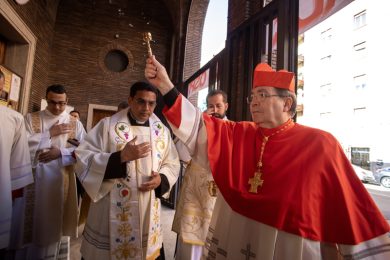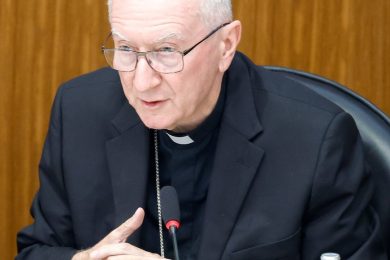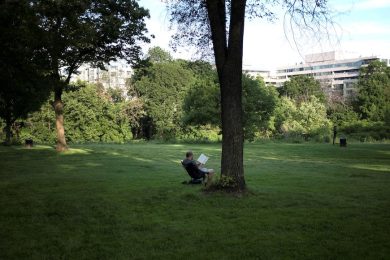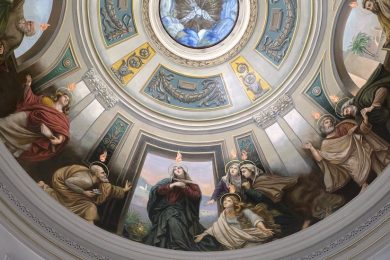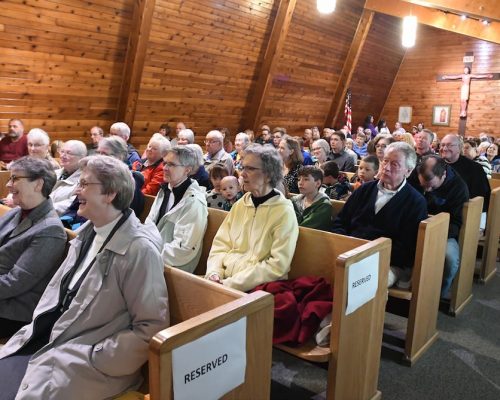Along bustling Highway 169, timbers of red, green, bright blue and yellow beckon visitors to the tiny church nestled in the trees on the Mille Lacs reservation.
That’s the way Benedictine Sister Laura Hesch imagined it when she chose the site for St. Therese of the Little Flower Church in Vineland in 1954. The colors making up both an exterior and interior wall of the church are symbolic to the native people, representing elements of the earth.
“This church building — and every church building — has spiritual architecture,” said Crosier Father Jerry Schik, pastor of the parish. “That means that the final result is the result of a preliminary vision. And the vision for this church is contained in the word ‘harmony.’
“When the plans were drawn up for the parish in 1954, this Catholic community was being served by the Benedictine sisters and the Crosier Fathers and Brothers, and both communities emphasize community life and harmony in the house,” Father Schik said.
“The vision for this building is to emphasize the harmonious relationship of Native American spiritual values and Christian spiritual values. They are not identical but they have so much in common,” he said. “And no one knew that better than Kateri Tekakwitha. She saw and felt the presence of the spirit in both spiritualities. They do not contradict each other. Rather they enrich each other.”
In a celebration Sept. 30, both the Benedictine sisters and St. Kateri Tekakwitha were honored. The sisters were recognized for their 60-year legacy at the mission church from 1941 to 2001. Bishop Donald Kettler concelebrated Mass with Father Schik, and blessed a commemorative sign honoring the sisters’ contributions.
Accompanied by children wearing native jingle dresses, Benedictine Prioress Susan Rudolph came forward to receive the plaque on behalf of the sisters. The plaque will be hung in the Vineland church.
Bishop Kettler also blessed new artwork for the church depicting St. Kateri Tekakwitha, the first Native American woman to be recognized as a saint by the Catholic Church in 2012.
After searching through many options, the parish settled on an image by artist Sheila Diemert. Father Schik said this celebration was another way to recognize the cultural contributions of the native people.
“As missionaries go out, they discover all the riches that come back to them,” he said. “Every group we go to in the world, every nation or tribe, they enrich our Catholic culture. That is how mission works. You will come away more rich than if you stay home. It is not just helping some folks, but it is opening the door for them to help make us more spiritually wealthy. St. Kateri helps us to know the messages God is sending us through nature.”
Barb Welty has been a member of St. Therese since before the building existed. In 1952, when she married, the parish was using a Quonset hut for the church. Her father-in-law was a trustee at the time. Later, her husband became trustee and when he died, she became a trustee. The church currently has 21 registered families.
Sister Laura assisted in the formation of all of Welty’s children, preparing them for the sacraments.
The cemetery at St. Therese is named for Welty’s son, Michael, who died as an infant and was the first to be buried there. Sister Laura, who died in 1972, also is buried there.
“This parish is so meaningful to my family,” Welty said. “And today is meaningful because Sister Laura and the sisters started the mission here. The natives just loved her and came to her for everything. They still very much respect that. They know what she and the sisters did here,” Welty said.
A meal and fellowship continued the celebration at a nearby convention center. Mike Yanta, who attends St. Therese with his four children, enjoyed the gathering.
“I liked the jingle dresses,” said Yanta’s daughter, Becky, 8. “And I liked to learn about the four colors.”
Father Schik explained during Mass that the number four holds great significance to the natives.
“The north wall is pitched at an angle to suggest the teepee of the Indian spiritual leader. The south wall contains stained glass windows to evoke the feeling of a Christian church. And the two are working together to hold up the roof. The outside walls and the inside walls contain stripes that have four colors because the number four is sacred within native spirituality. Why? Because the number four was given to us by the Creator who handed to us the four winds, the four seasons and the four directions,” Father Schik said in his homily.
Yanta appreciated the opportunity to celebrate the diversity of the church and he was excited to learn something new along with his children.
“It was wonderful how Father Jerry explained the symbolism of the number four — the four colors, the four directions and that [Native Americans] are always buried on the fourth day,” he said. “My faith is very deep in me … my parents [instilled] that in me and I want to pass that on to my kids so they keep hold of their faith. Being able to bring them to something like this has been really amazing.”




